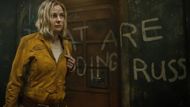When Silo premiered on Apple TV+ fans of Hugh Howey's bestselling Wool series were keen to discover how the creepy claustrophobic universe of the Silo would be brought to life on screen. What they were presented with was a remarkable adaptation that remained faithful to the heart of the story while forging an independent identity of its own.
Based on a post-apocalyptic underground world where all truth is stringently regulated, the show combines mystery, rebellion, and paranoia into a slow-burning science fiction thriller. Whereas the series pays homage to the atmosphere and themes of the source material, it's not shy about shaking things up.
From revised character development to narrative restructurings and subplots, Silo makes creative decisions that enrich and occasionally stray from Howey's original work. Some are subtle, adding to the emotional depth of the central characters. Others are dramatic, such as rearranging the timeline or fleshing out the rebellion storyline. For audiences who've read the novel, these variations provide a new interpretation and sometimes a few surprises.
Here, we explore seven big ways Silo deviates from the book on every twist, turn, and overhaul showing how adaptation can be both tribute and innovation.
Times Silo differed from the book it was adapted from
1. Juliette’s backstory is expanded

In the Silo series, Juliette Nichols is not only a skilled mechanic anymore. She's richly textured with emotional depth. The series returns to her childhood in Mechanical, dealing with her mother's absence and her toxic relationship with her father, Dr. Nichols.
These emotional layers are merely hinted at in Hugh Howey's Wool. By examining her trauma, mourning, and rebellious independence, the series enables the audience to resonate strongly with her rebellion. This depth of storytelling gives an added layer of vulnerability and humanity that makes her on-screen leadership all the more powerful, a daring move that distinguishes the show from others in tone and character building.
2. The character of Allison is given more depth

Allison Becker, Holston's wife, evolves from a shadowy figure in the book to an active woman in the series. Apple TV+ gives new life to her character by depicting her slide into paranoia and eventual rebellion as she learns the truth. Her hacking scenes, emotional breakdown, and desperate attempt at revealing the Silo's secrets are captivating and heartbreaking.
In the novel, she lives mostly through Holston's recollections. Conversely, the series gives her agency and plot importance, whereby her actions are the springboard for the whole show. This emotional investment makes her fate all the more heartbreaking to witness.
3. Mayor Jahns plays a larger role in the series

In the novel, Mayor Ruth Jahns is a cameo character at best, dignified but not crucial. The show remakes her as an intensely committed politician playing political chess. From opposing Judicial overreach to selecting Juliette as sheriff, her decisions affect the story.
Played expertly by Geraldine James, Jahns' character serves as a moral compass in the face of rising corruption. Her increased role deepens the feeling of loss when she experiences an emotional scene that reinforces the series' larger themes of institutional rot. By assigning her greater significance the show deepens the political tension that runs through the upper echelons of the Silo.
4. The timeline is more linear in the show

Hugh Howey's Wool manipulates timelines and points of view, divulging plot elements in a non-linear fashion. The television show, on the other hand, takes a more linear, traditional approach, something possibly done for accessibility to larger crowds. This accomplishes an easier narrative but alters tension-building.
Plot points such as Holston's and Allison's deaths occur early in the series and are a definite springboard for Juliette's journey. This condensed chronology provides clarity but strips away the puzzle-box experience the book presents. Nevertheless, it permits rich character development and suspense to arise organically throughout episodes, incrementing tension with each subsequent reveal.
5. The series adds original characters and subplots

The Apple TV+ take doesn't hold back on invention. Paul Billings, revealed early on with his syndrome and sense of morality, is either fleshed out or entirely new. Judicial's surveillance technology and the entrenched rot of Silo politics at the center widen the canvas considerably. These additions increase the show's thriller tone, turning it from a dystopian mystery into a sociopolitical thriller.
The novel is more concerned with the physical enigma of the external world. However, the series implies that power struggles and manipulation within are equally deadly, making its world-building even more terrifying.
6. The reveal of the outside world is delayed

The book doesn't wait to unveil the exterior. Holston's and Allison's suicides immediately reveal the emptiness behind the Silo's walls. The show, however, doesn't take that route, building suspense. Rather than answers, it provides glimpses of conspiracy, misinformation, and tension.
Juliette's ascent is a metaphorical and actual rise towards truth. This delay is not mere drama. It reflects our own gradual awakening to institutional deceit. When the reveal does happen, it lands with seismic emotional power. The suspense pays off, not just as tension but as a question about our need to know and what we are willing to pay to have it.
7. The show emphasizes a more widespread rebellion theme

Though the Wool novel centers on Juliette's investigation, the show develops a more communal resistance story. From brewing discontent in the Mechanical to quiet acts of resistance in porters and engineers, rebellion is a collective beat.
The show intentionally sows seeds of solidarity, whispers of rebellion that span far beyond Juliette's own movements. It offers up a society hanging in the balance, not merely as a result of one woman's fascination but as the product of mass discontent. This construction captures contemporary issues of systemic opposition and group solidarity, allowing the tale to seem more current, politically relevant, and emotionally accessible to modern audiences.
Whereas adaptations tend to sit precariously on the fence between faithfulness and invention, Silo finds a winning balance. The series stays true to Hugh Howey's vision but boldly grows its world with more nuanced characters, multi-layered subplots, and contemporary themes.
These seven variations do not debase the original material but bring new depth and expanded emotional range for a contemporary audience to appreciate. Whether you’re a longtime fan of the books or a newcomer intrigued by the mystery of the Silo these creative changes make the story feel both familiar and refreshingly new. In this case, divergence isn’t a flaw, it’s a strength.
